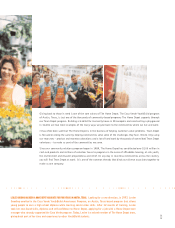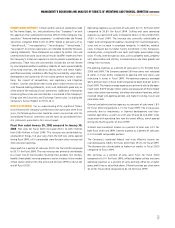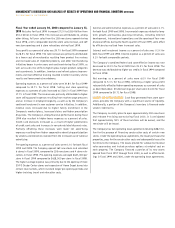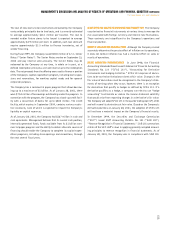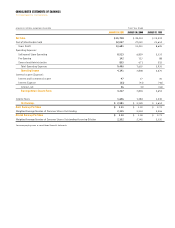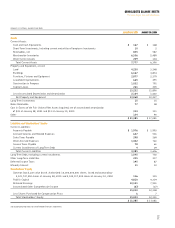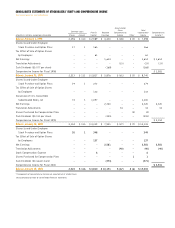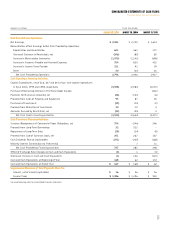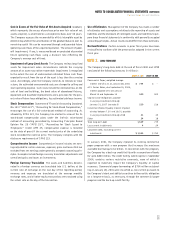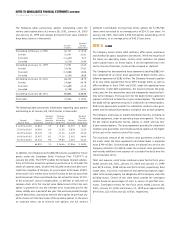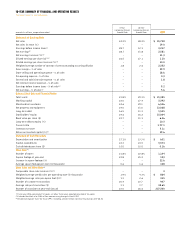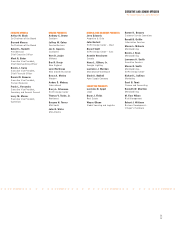Home Depot 2000 Annual Report Download - page 27
Download and view the complete annual report
Please find page 27 of the 2000 Home Depot annual report below. You can navigate through the pages in the report by either clicking on the pages listed below, or by using the keyword search tool below to find specific information within the annual report.
Notes to Consolidated Financial Statements (continued)
The Home Depot, Inc. and Subsidiaries
24
25
Cost in Excess of the Fair Value of Net Assets Acquired Goodwill,
which represents the excess of purchase price over fair value of net
assets acquired, is amortized on a straight-line basis over 40 years.
The Company assesses the recoverability of this intangible asset by
determining whether the amortization of the goodwill balance over its
remaining useful life can be recovered through undiscounted future
operating cash flows of the acquired operation. The amount of good-
will impairment, if any, is measured based on projected discounted
future operating cash flows using a discount rate reflecting the
Company’s average cost of funds.
Impairment of Long-Lived Assets The Company reviews long-lived
assets for impairment when circumstances indicate the carrying
amount of an asset may not be recoverable. Impairment is recognized
to the extent the sum of undiscounted estimated future cash flows
expected to result from the use of the asset is less than the carrying
value. Accordingly, when the Company commits to relocate or close
a store, the estimated unrecoverable costs are charged to selling and
store operating expense. Such costs include the estimated loss on the
sale of land and buildings, the book value of abandoned fixtures,
equipment and leasehold improvements and a provision for the pres-
ent value of future lease obligations, less estimated sub-lease income.
Stock Compensation Statement of Financial Accounting Standards
No. 123 (“SFAS 123”), “Accounting for Stock-Based Compensation,”
encourages the use of a fair-value-based method of accounting. As
allowed by SFAS 123, the Company has elected to account for its
stock-based compensation plans under the intrinsic value-based
method of accounting prescribed by Accounting Principles Board
Opinion No. 25 (“APB 25”), “Accounting for Stock Issued to
Employees.” Under APB 25, compensation expense is recorded
on the date of grant if the current market price of the underlying
stock exceeded the exercise price. The Company complies with the
disclosure requirements of SFAS 123.
Comprehensive Income Comprehensive income includes net earn-
ings adjusted for certain revenues, expenses, gains and losses that are
excluded from net earnings under generally accepted accounting prin-
ciples. Examples include foreign currency translation adjustments and
unrealized gains and losses on investments.
Foreign Currency Translation The assets and liabilities denomi-
nated in a foreign currency are translated into U.S. dollars at the
current rate of exchange on the last day of the reporting period,
revenues and expenses are translated at the average monthly
exchange rates, and all other equity transactions are translated using
the actual rate on the day of the transaction.
Use of Estimates Management of the Company has made a number
of estimates and assumptions relating to the reporting of assets and
liabilities and the disclosure of contingent assets and liabilities to pre-
pare these financial statements in conformity with generally accepted
accounting principles. Actual results could differ from these estimates.
Reclassifications Certain amounts in prior fiscal years have been
reclassified to conform with the presentation adopted in the current
fiscal year.
Note 2. Long-Term Debt
The Company’s long-term debt at the end of fiscal 2000 and 1999
consisted of the following (amounts in millions):
January 28, 2001 January 30, 2000
Commercial Paper; weighted average
interest rate of 6.1% at January 28, 2001
$ 754
$–
61⁄2% Senior Notes; due September 15, 2004;
interest payable semi-annually on
March 15 and September 15
500
500
Capital Lease Obligations; payable
in varying installments through
January 31, 2027 (see note 5)
230
216
Installment Notes Payable; interest imputed
at rates between 7.2% and 10.0%; payable
in varying installments through 2018
41
45
Other
24
18
Total long-term debt
1,549
779
Less current installments
4
29
Long-term debt, excluding current
installments
$ 1,545
$ 750
In January 2001, the Company replaced its existing commercial
paper program with a new program that increases the maximum
available borrowings to $1 billion. In connection with the program,
the Company has a back-up credit facility with a consortium of banks
for up to $800 million. The credit facility, which expires in September
2004, contains various restrictive covenants, none of which is
expected to materially impact the Company’s liquidity or capital
resources. Commercial paper borrowings of $754 million outstand-
ing at January 28, 2001 were classified as non-current pursuant to
the Company’s intent and ability to continue to finance this obligation
on a long-term basis, as necessary, through the commercial paper
program and the back-up credit facility.


